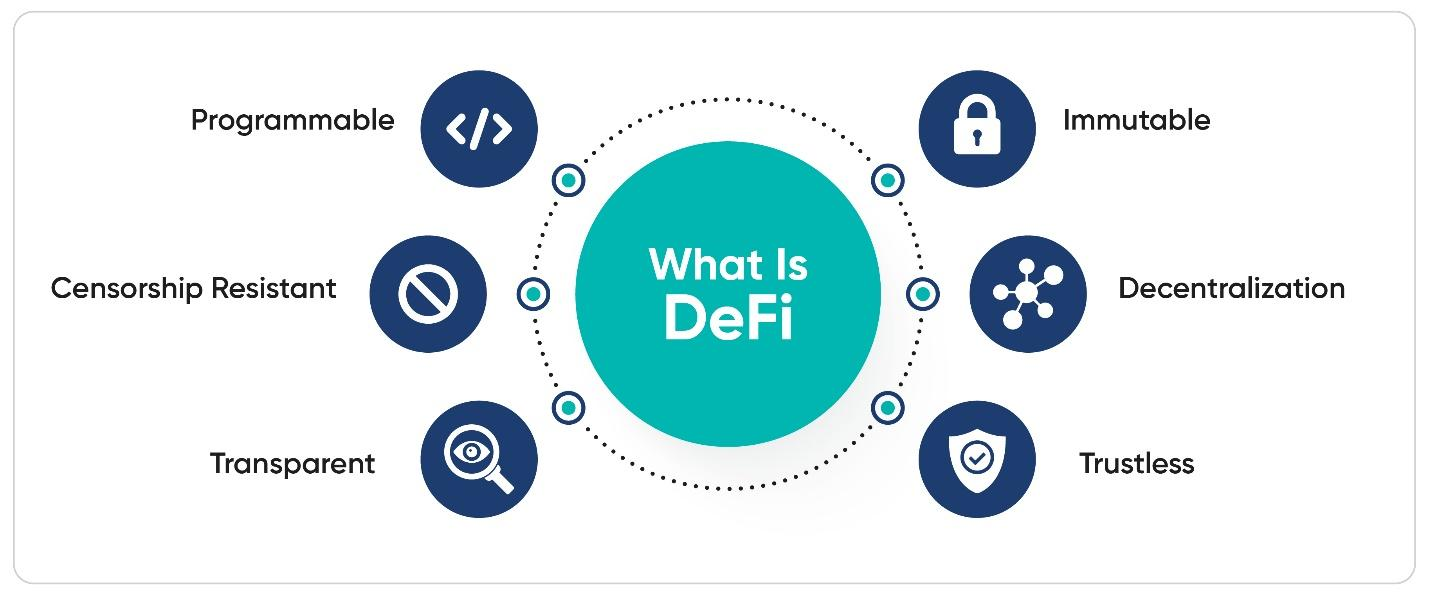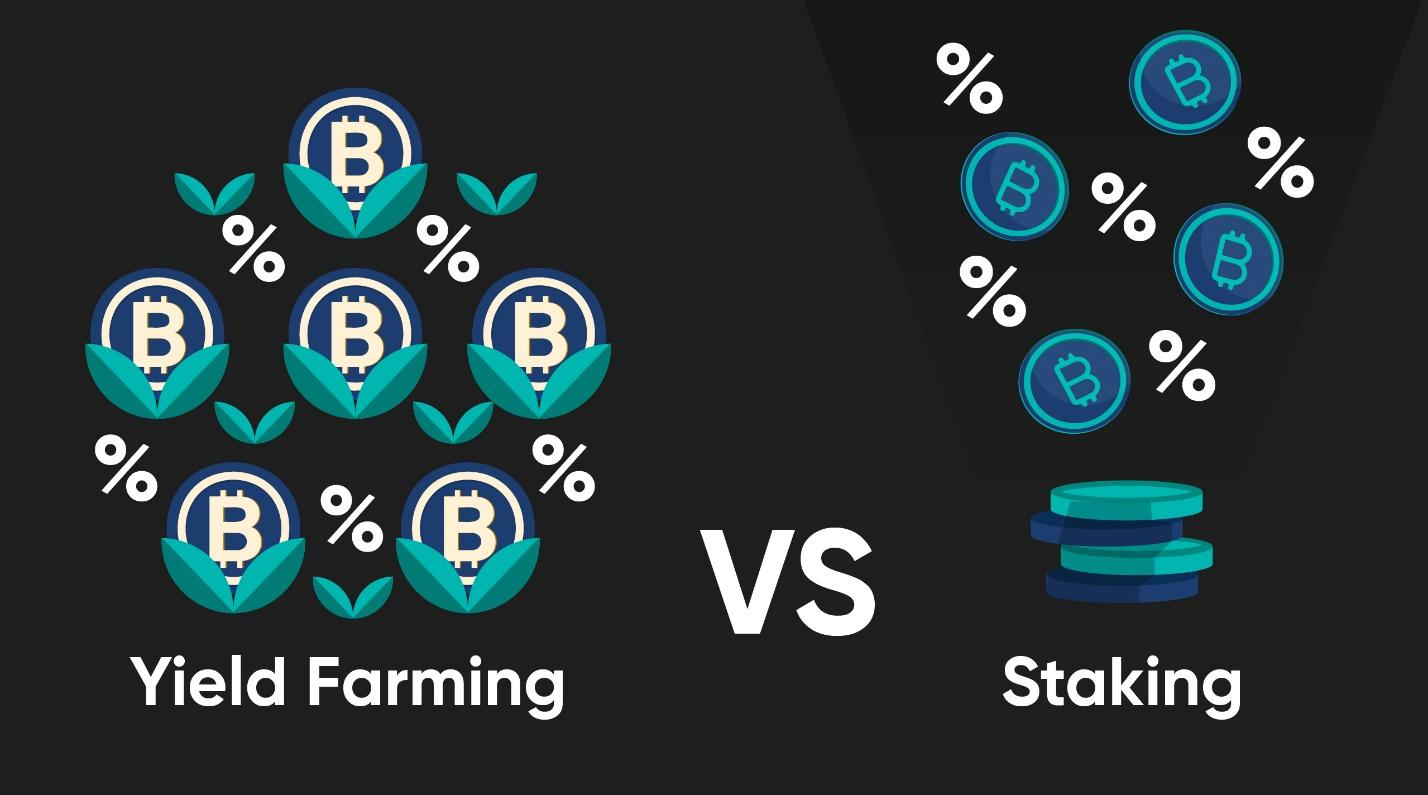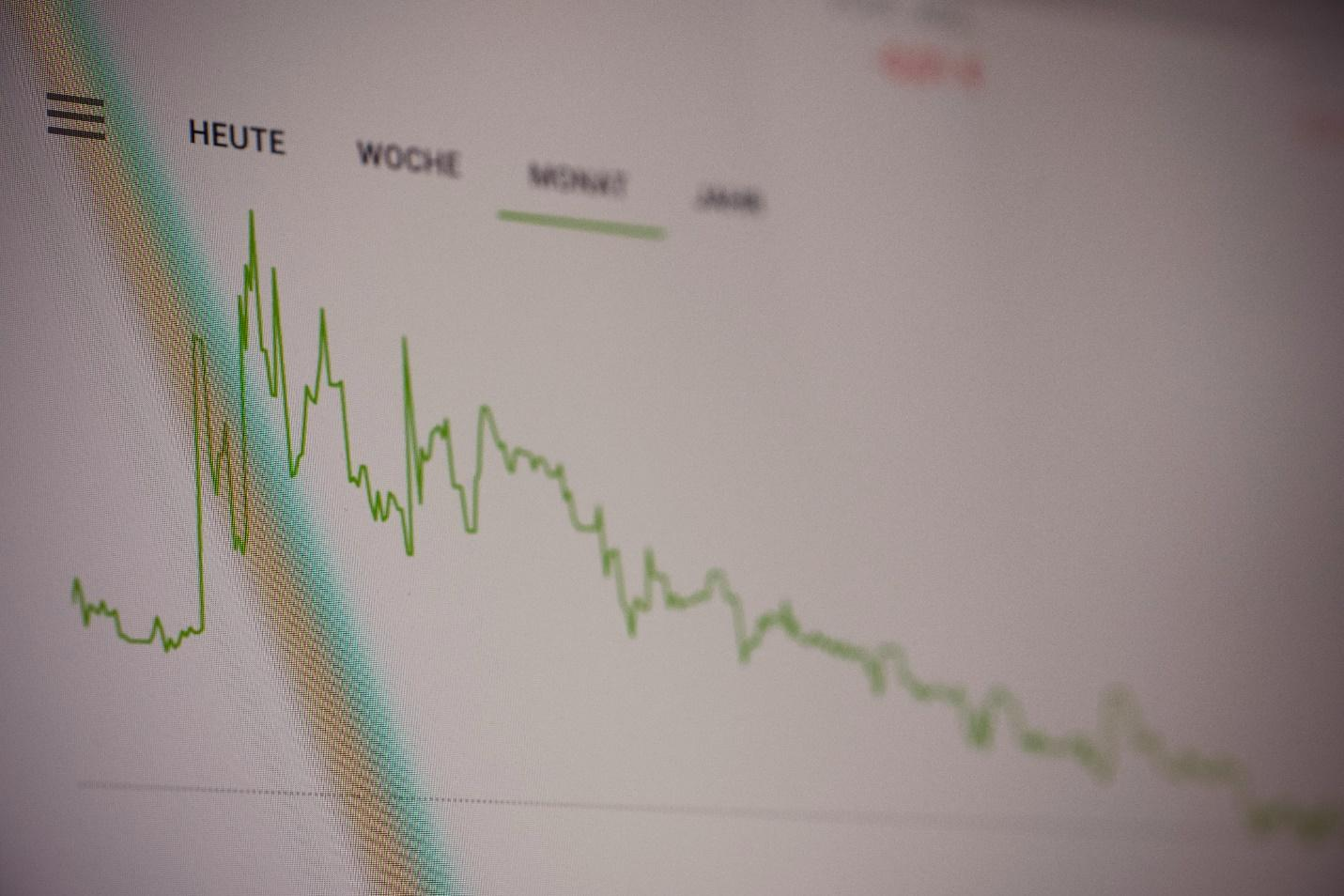The world of finance has witnessed a seismic shift. Traditional financial systems, with their centralized control and inherent inefficiencies, are being challenged by a new paradigm known as decentralized finance (DeFi). As the name suggests, DeFi represents a financial ecosystem that is decentralized, operating without the need for traditional intermediaries like banks, brokerages, or exchanges. Instead, it leverages blockchain technology to offer a transparent, open, and permissionless financial system.
In this power blog, we will explore the fundamental concepts of DeFi, its key components, and the potential it holds to revolutionize the financial industry. Regardless of your level of experience, this guide will provide valuable insights into the DeFi ecosystem and its implications for the future of finance.
What is DeFi?
DeFi, short for decentralized finance, refers to a collection of financial services that are built on blockchain technology, primarily Ethereum, but also expanding to other platforms like Binance Smart Chain, Solana, and more. Unlike traditional financial systems that rely on centralized institutions, DeFi functions using smart contracts, which are self-executing agreements with the contract terms embedded directly in the code.

These smart contracts allow DeFi applications (often referred to as DApps) to offer a wide range of financial services, including lending, borrowing, trading, and investing, without the need for intermediaries. The core principles of DeFi are transparency, accessibility, and decentralization. By eliminating the middleman, DeFi aims to democratize access to financial services, reduce costs, and increase efficiency.
The Evolution of DeFi
To fully appreciate the impact of DeFi, it’s essential to understand its evolution. The concept of decentralized finance isn’t entirely new, but it gained significant traction with the rise of blockchain technology and cryptocurrencies, particularly Bitcoin. Bitcoin introduced the idea of a decentralized currency, one that operates without the need for a central authority like a government or bank.
As blockchain technology matured, developers began to realize that the same principles could be applied to a broader range of financial services. This led to the creation of Ethereum, a blockchain platform that supports smart contracts and decentralized applications. Ethereum became the foundation for the DeFi movement, allowing developers to create a wide array of financial services that operate without intermediaries.
The first wave of DeFi projects focused on simple financial products like lending and borrowing, but as the ecosystem grew, more complex financial instruments, such as derivatives, insurance, and decentralized exchanges (DEXs), emerged. Today, the DeFi ecosystem is a thriving, multi-billion-dollar industry with a wide range of applications and services.
Key Components of DeFi
DeFi is composed of several key components that work together to create a decentralized financial ecosystem. These components include decentralized exchanges (DEXs), lending and borrowing platforms, stablecoins, yield farming, and more. Let’s explore each of these in detail.
1. Decentralized Exchanges (DEXs)
Decentralized exchanges are platforms that allow users to trade cryptocurrencies directly with one another without the need for a central authority or intermediary. Unlike traditional exchanges, which are controlled by a single entity, DEXs operate on a peer-to-peer basis, using smart contracts to facilitate trades.
Some popular DEXs include Uniswap, SushiSwap, and PancakeSwap. These platforms have gained popularity due to their ability to offer a wide range of trading pairs, lower fees, and greater privacy compared to centralized exchanges. Additionally, DEXs often provide users with the ability to earn passive income through liquidity provision, a process known as yield farming.
2. Lending and Borrowing Platforms
Lending and borrowing are fundamental financial services, and DeFi has revolutionized how these services are offered. DeFi lending platforms allow users to lend their cryptocurrencies to others in exchange for interest. Borrowers, on the other hand, can obtain loans by providing collateral in the form of digital assets.
Platforms like Aave, Compound, and MakerDAO are some of the leading players in this space. These platforms use smart contracts to automate the lending and borrowing process, ensuring transparency and reducing the risk of default. Additionally, DeFi lending platforms often offer higher interest rates compared to traditional savings accounts, making them attractive to investors.
3. Stablecoins
Stablecoins are a crucial component of the DeFi ecosystem. These are cryptocurrencies that are pegged to the value of a fiat currency, such as the US dollar, or other assets like gold. Stablecoins aim to provide the benefits of cryptocurrencies—such as fast transactions and low fees—while minimizing the volatility associated with traditional cryptocurrencies like Bitcoin and Ethereum.

Some popular stablecoins include USDT (Tether), USDC (USD Coin), and DAI. Stablecoins are widely used in DeFi for trading, lending, and as a store of value. They also play a vital role in providing liquidity to decentralized exchanges and other DeFi protocols.
4. Yield Farming and Liquidity Mining
Yield farming, synonymous with liquidity mining, is a lucrative strategy within the decentralized finance (DeFi) ecosystem that allows users to generate passive income by contributing assets to liquidity pools. These pools are essentially reservoirs of digital assets that power decentralized exchanges (DEXs) and other DeFi applications. By providing liquidity, users become integral to the platform’s operations and are compensated for their contributions.
The mechanics of yield farming involve depositing an equivalent value of two specific cryptocurrencies into a liquidity pool. In return, users receive liquidity provider (LP) tokens representing their share of the pool. These LP tokens can be staked on the DeFi platform to earn rewards, typically in the form of the platform’s native governance token or a combination of platform tokens and trading fees.
The Basics of Tokenization: What You Need to Know

The allure of yield farming lies in the potential for substantial returns. As the platform grows and facilitates more transactions, the value of LP tokens can appreciate, amplifying gains for liquidity providers. Additionally, the rewards earned from staking LP tokens can be substantial, especially during periods of high platform activity.
However, it’s essential to approach yield farming with caution. One of the primary risks is impermanent loss. This occurs when the price of the deposited assets diverges significantly, resulting in a loss when withdrawing liquidity. Moreover, the DeFi space is relatively new and subject to smart contract vulnerabilities, which could lead to the loss of funds. It’s crucial to conduct thorough research, understand the risks involved, and only invest what you can afford to lose.
Diversifying across multiple platforms and constantly monitoring market conditions can help mitigate risks. Ultimately, while yield farming offers the potential for significant returns, it requires a deep understanding of DeFi concepts and a prudent investment approach.
5. DeFi Derivatives
DeFi derivatives are financial instruments that derive their value from an underlying asset, such as a cryptocurrency, commodity, or stock. These derivatives can be used for hedging, speculation, or risk management. In the DeFi space, derivatives are often used to create synthetic assets, which are digital representations of real-world assets.
Platforms like Synthetix and Mirror Protocol are leading players in the DeFi derivatives space. These platforms allow users to create and trade synthetic assets, enabling exposure to traditional financial markets without the need for intermediaries.
6. Decentralized Insurance
DeFi has also introduced the concept of decentralized insurance, which aims to provide coverage for various risks associated with the DeFi ecosystem. Decentralized insurance platforms use smart contracts to pool funds from users, which are then used to pay out claims in the event of an insured event, such as a smart contract failure or a hacking incident.
Nexus Mutual and Cover Protocol are examples of decentralized insurance platforms. These platforms offer coverage for a range of risks, including smart contract vulnerabilities, exchange hacks, and stablecoin depegging.
The Benefits of DeFi
DeFi offers several advantages over traditional financial systems, making it an attractive option for both investors and everyday users. Here are some of the key benefits of DeFi:
1. Accessibility
One of the most significant advantages of DeFi is its accessibility. Traditional financial services are often limited by geographic location, credit history, and other factors. In contrast, DeFi is open to anyone with an internet connection and a digital wallet. This inclusivity allows individuals in underserved or unbanked regions to access financial services that were previously out of reach.
2. Transparency
DeFi operates on blockchain technology, which is inherently transparent. Every transaction, contract, and operation is recorded on a public ledger, allowing anyone to verify the accuracy and legitimacy of the data. This transparency reduces the risk of fraud and corruption, as all activities are open to scrutiny.
3. Reduced Costs
By eliminating intermediaries, DeFi significantly reduces the costs associated with financial services. Traditional banks and financial institutions charge fees for their services, which can add up over time. In contrast, DeFi platforms often have lower fees, as they rely on automated smart contracts rather than manual processes.

4. Innovation and Flexibility
The DeFi ecosystem is constantly evolving, with new projects and protocols being launched regularly. This rapid pace of innovation allows users to access a wide range of financial products and services that are tailored to their needs. Additionally, DeFi is highly flexible, allowing users to customize their financial strategies and take advantage of new opportunities as they arise.
5. Control and Ownership
In the traditional financial system, users often have limited control over their assets, as they are held and managed by banks or other institutions. DeFi gives users full control and ownership of their digital assets, as they are stored in decentralized wallets that only the user has access to. This control extends to the ability to participate in governance decisions for DeFi protocols, giving users a say in the future development of the ecosystem.
The Challenges of DeFi
While DeFi offers numerous benefits, it also comes with its own set of challenges and risks. It’s important for users to be aware of these challenges before diving into the world of DeFi.
1. Security Risks
DeFi platforms are built on smart contracts, which are code-based agreements that automatically execute transactions. While smart contracts offer transparency and efficiency, they are also vulnerable to coding errors and exploits. In the past, several DeFi platforms have been hacked, resulting in significant losses for users. As a result, security remains a top concern for the DeFi community.
To mitigate these risks, many DeFi platforms undergo rigorous security audits, and users are encouraged to exercise caution when interacting with new or untested protocols. Additionally, decentralized insurance platforms, such as Nexus Mutual, provide coverage for smart contract failures, offering users an added layer of protection.
2. Regulatory Uncertainty
DeFi operates in a relatively new and rapidly evolving regulatory environment. While some countries have embraced blockchain technology and cryptocurrencies, others have imposed strict regulations or outright bans. The lack of clear regulatory guidelines creates uncertainty for DeFi projects and users, as they navigate the complexities of compliance.
Moreover, as DeFi continues to grow, it is likely to attract increased scrutiny from regulators. This could lead to the introduction of new laws and regulations that could impact the development and adoption of DeFi. It is essential for DeFi projects to work closely with legal and regulatory teams to ensure compliance and mitigate potential risks.
3. Market Volatility
The cryptocurrency market is known for its volatility, and this extends to the DeFi ecosystem. The value of digital assets can fluctuate dramatically in a short period, leading to significant gains or losses for users. While stablecoins provide a measure of stability, they are not immune to market forces, and their value can also be affected by external factors.

To manage this risk, users should diversify their portfolios and consider using DeFi tools, such as derivatives and hedging strategies, to protect against market volatility. Additionally, consulting with a digital asset management consultant can provide valuable insights and help users develop a robust investment strategy.
4. User Experience
Despite its rapid growth, DeFi still faces challenges related to user experience. Many DeFi platforms have complex interfaces that can be difficult for beginners to navigate. Additionally, the process of setting up a digital wallet, interacting with smart contracts, and managing digital assets can be intimidating for new users.
To address these challenges, the DeFi community is focused on improving user experience through better design, educational resources, and customer support.
The Future of DeFi
The future of DeFi is filled with potential and promise. As the ecosystem continues to grow, it is likely to play an increasingly important role in the global financial system. Here are some key trends and developments to watch in the coming years:
1. Integration with Traditional Finance
One of the most significant developments in the DeFi space is the integration with traditional finance (TradFi). As DeFi matures, we are likely to see more collaboration between decentralized and centralized financial institutions. This could include partnerships between DeFi projects and traditional banks, the integration of DeFi services into existing financial platforms, and the development of hybrid financial products that combine the best of both worlds.
For example, several traditional financial institutions are already exploring the use of blockchain technology for cross-border payments, asset tokenization, and more. Real asset tokenization investment consultants are helping bridge the gap between the DeFi and TradFi worlds by advising on the tokenization of real-world assets (RWAs) and their integration into decentralized platforms.

2. Growth of Decentralized Autonomous Organizations (DAOs)
Decentralized Autonomous Organizations (DAOs) are a new form of organization that operates entirely on the blockchain, governed by smart contracts and token holders. DAOs are becoming increasingly popular in the DeFi space, as they offer a transparent and democratic way to manage projects and allocate resources.
In the future, DAOs are likely to play a central role in the governance of DeFi protocols, allowing users to participate in decision-making processes and shape the direction of the ecosystem. This could lead to more community-driven innovation and a more inclusive financial system.
3. Expansion of DeFi Use Cases
While DeFi is currently focused on financial services like lending, borrowing, and trading, the potential use cases are far broader. In the coming years, we can expect to see DeFi expand into areas such as insurance, real estate, supply chain management, and more. This expansion will be driven by the continued development of blockchain technology and the growing adoption of digital assets.
Consultants specializing in blockchain and digital asset consulting will play a crucial role in this expansion by helping businesses and startups navigate the complexities of DeFi and develop strategies for integrating decentralized technologies into their operations.
4. Enhanced Privacy and Security
Privacy and security are ongoing concerns in the DeFi space, and we are likely to see continued efforts to address these issues. This could include the development of new privacy-focused protocols, the implementation of advanced encryption techniques, and the use of zero-knowledge proofs to protect user data.
Additionally, as DeFi platforms continue to grow in popularity, they will need to prioritize security to protect users from hacks and exploits. This will require ongoing collaboration between DeFi projects, security auditors, and digital asset consulting firms that specialize in compliance and risk management.
5. Increased Institutional Adoption
Institutional adoption of DeFi is already underway, with hedge fund investment companies, family offices, and other large investors beginning to explore the opportunities offered by decentralized finance. As DeFi continues to mature, we can expect to see more institutional involvement, leading to increased liquidity, more sophisticated financial products, and greater market stability.
Consultancy firms specializing in DeFi finance investments and digital asset management will play a key role in guiding institutions through this transition, providing insights into the most promising investment opportunities and helping them navigate the unique challenges of the DeFi space.
Conclusion
Decentralized finance represents a bold new vision for the future of finance, one that is open, transparent, and accessible to all. By leveraging blockchain technology, DeFi has the potential to disrupt traditional financial systems, reduce costs, and democratize access to financial services.
However, as with any emerging technology, DeFi comes with its own set of challenges and risks. Security, regulatory uncertainty, and market volatility are just a few of the issues that users must navigate. To successfully participate in the DeFi ecosystem, it is essential to stay informed, exercise caution, and seek guidance from people in the field.
DeFi offers a wealth of opportunities to explore. From stablecoin investment consultants to digital asset strategy consulting firms, there is no shortage of expertise available to help you make the most of this exciting new frontier.
As we look to the future, one thing is clear: DeFi is not just a trend—it’s a fundamental shift in how we think about and interact with money. The rise of decentralized finance marks the beginning of a new era, one that promises to reshape the financial landscape and empower individuals around the world. Embrace the future of finance, and explore the limitless possibilities that DeFi has to offer.
Start Learning
At Kenson Investments, we believe that knowledge is the foundation of smart financial decisions. Our commitment is to empower you with the understanding and insights needed to navigate the complex world of finance, including digital asset management consultant services and cryptocurrency investment consultant expertise. Whether you’re new to the market or looking to deepen your understanding of digital asset portfolio management, cryptocurrency investment solutions, stablecoins for investment, or altcoin investment, our team is here to guide you every step of the way. Discover the confidence that comes from being informed—connect with Kenson Investments today and start your journey toward financial literacy.
Disclaimer: The information provided on this page is for educational and informational purposes only and should not be construed as financial advice. Crypto currency assets involve inherent risks, and past performance is not indicative of future results. Always conduct thorough research and consult with a qualified financial advisor before making investment decisions.
“The crypto currency and digital asset space is an emerging asset class that has not yet been regulated by the SEC and US Federal Government. None of the information provided by Kenson LLC should be considered as financial investment advice. Please consult your Registered Financial Advisor for guidance. Kenson LLC does not offer any products regulated by the SEC including, equities, registered securities, ETFs, stocks, bonds, or equivalents”














